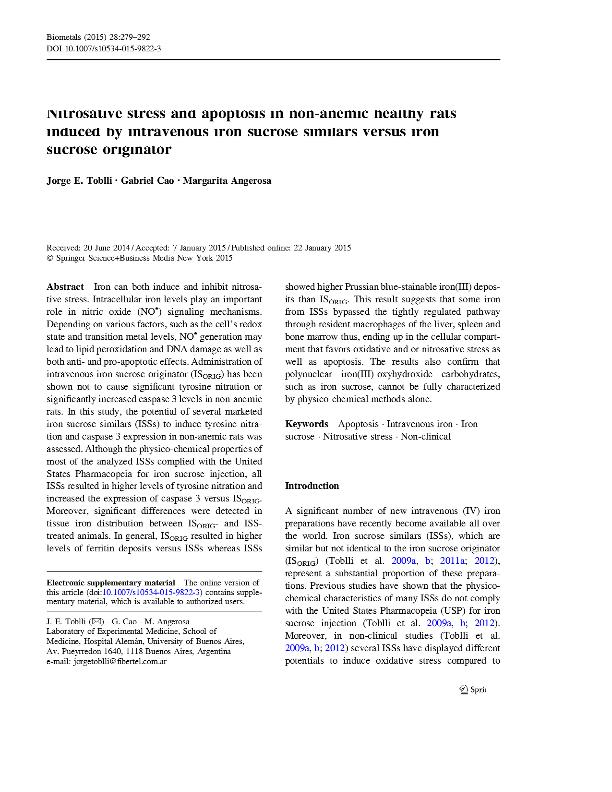Mostrar el registro sencillo del ítem
dc.contributor.author
Toblli, Jorge Eduardo

dc.contributor.author
Cao, Gabriel Fernando

dc.contributor.author
Angerosa, Margarita

dc.date.available
2018-03-02T20:22:08Z
dc.date.issued
2015-04
dc.identifier.citation
Toblli, Jorge Eduardo; Cao, Gabriel Fernando; Angerosa, Margarita; Nitrosative stress and apoptosis in non-anemic healthy rats induced by intravenous iron sucrose similars versus iron sucrose originator; Springer; Biometals; 28; 2; 4-2015; 279-292
dc.identifier.issn
0966-0844
dc.identifier.uri
http://hdl.handle.net/11336/37728
dc.description.abstract
Iron can both induce and inhibit nitrosative stress. Intracellular iron levels play an important role in nitric oxide (NO•) signaling mechanisms. Depending on various factors, such as the cell's redox state and transition metal levels, NO• generation may lead to lipid peroxidation and DNA damage as well as both anti- and pro-apoptotic effects. Administration of intravenous iron sucrose originator (ISORIG) has been shown not to cause significant tyrosine nitration or significantly increased caspase 3 levels in non-anemic rats. In this study, the potential of several marketed iron sucrose similars (ISSs) to induce tyrosine nitration and caspase 3 expression in non-anemic rats was assessed. Although the physico-chemical properties of most of the analyzed ISSs complied with the United States Pharmacopeia for iron sucrose injection, all ISSs resulted in higher levels of tyrosine nitration and increased the expression of caspase 3 versus ISORIG. Moreover, significant differences were detected in tissue iron distribution between ISORIG- and ISS-treated animals. In general, ISORIG resulted in higher levels of ferritin deposits versus ISSs whereas ISSs showed higher Prussian blue-stainable iron(III) deposits than ISORIG. This result suggests that some iron from ISSs bypassed the tightly regulated pathway through resident macrophages of the liver, spleen and bone marrow thus, ending up in the cellular compartment that favors oxidative and or nitrosative stress as well as apoptosis. The results also confirm that polynuclear iron(III)-oxyhydroxide carbohydrates, such as iron sucrose, cannot be fully characterized by physico-chemical methods alone.
dc.format
application/pdf
dc.language.iso
eng
dc.publisher
Springer

dc.rights
info:eu-repo/semantics/openAccess
dc.rights.uri
https://creativecommons.org/licenses/by-nc-sa/2.5/ar/
dc.subject
Apoptosis
dc.subject
Intravenous Iron
dc.subject
Iron Sucrose
dc.subject
Nitrosative Stress
dc.subject
Non-Clinical
dc.subject.classification
Patología

dc.subject.classification
Medicina Básica

dc.subject.classification
CIENCIAS MÉDICAS Y DE LA SALUD

dc.title
Nitrosative stress and apoptosis in non-anemic healthy rats induced by intravenous iron sucrose similars versus iron sucrose originator
dc.type
info:eu-repo/semantics/article
dc.type
info:ar-repo/semantics/artículo
dc.type
info:eu-repo/semantics/publishedVersion
dc.date.updated
2018-03-02T17:36:49Z
dc.identifier.eissn
1572-8773
dc.journal.volume
28
dc.journal.number
2
dc.journal.pagination
279-292
dc.journal.pais
Estados Unidos

dc.journal.ciudad
Nueva York
dc.description.fil
Fil: Toblli, Jorge Eduardo. Hospital Alemán. Laboratorio de Medicina Experimental; Argentina. Consejo Nacional de Investigaciones Científicas y Técnicas. Oficina de Coordinación Administrativa Houssay. Instituto de Investigaciones Cardiológicas. Universidad de Buenos Aires. Facultad de Medicina. Instituto de Investigaciones Cardiológicas; Argentina
dc.description.fil
Fil: Cao, Gabriel Fernando. Consejo Nacional de Investigaciones Científicas y Técnicas. Oficina de Coordinación Administrativa Houssay. Instituto de Investigaciones Cardiológicas. Universidad de Buenos Aires. Facultad de Medicina. Instituto de Investigaciones Cardiológicas; Argentina. Hospital Alemán. Laboratorio de Medicina Experimental; Argentina
dc.description.fil
Fil: Angerosa, Margarita. Universidad de Buenos Aires. Facultad de Medicina; Argentina. Hospital Alemán. Laboratorio de Medicina Experimental; Argentina
dc.journal.title
Biometals

dc.relation.alternativeid
info:eu-repo/semantics/altIdentifier/doi/http://dx.doi.org/10.1007/s10534-015-9822-3
dc.relation.alternativeid
info:eu-repo/semantics/altIdentifier/url/https://link.springer.com/article/10.1007%2Fs10534-015-9822-3
Archivos asociados
